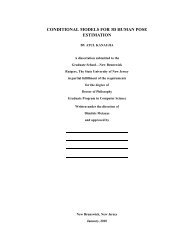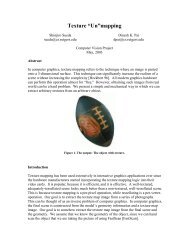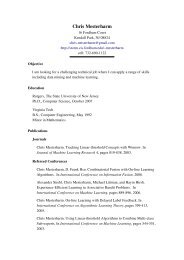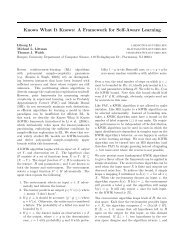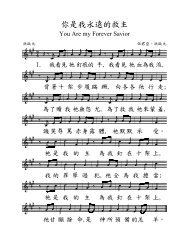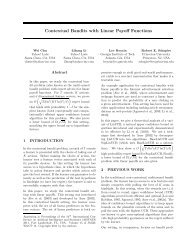Composition theorems in communication complexity
Composition theorems in communication complexity
Composition theorems in communication complexity
Create successful ePaper yourself
Turn your PDF publications into a flip-book with our unique Google optimized e-Paper software.
Proof. Let H 2 be the subspace consist<strong>in</strong>g functions f : G × G → C s.t. f(s, t) = f(s ′ , t ′ ) if<br />
s ∼ s ′ , t ∼ t ′ . Note that for direct product group G × G, {χ i ⊗ χ j : i, j} form an orthogonal<br />
basis of H 2 :<br />
∑<br />
s,t∈G<br />
χ i (s)χ j (t)χ i ′(s)χ j ′(t) = ( ∑<br />
χ i (s)χ i ′(s) )( ∑<br />
χ j (t)χ j ′(t) ) = 0<br />
s∈G<br />
unless i = i ′ and j = j ′ . Note that by view<strong>in</strong>g T as a function from G × G to C, the Eq. (6)<br />
and the def<strong>in</strong>ition of T ′ imply that<br />
Thus the first two statements are equivalent.<br />
Note that<br />
〈χ i ⊗ χ j , T 〉 = 0, ∀i ≠ j<br />
t∈G<br />
T ′ ∈ span{χ i ⊗ χ i : i ∈ [h]} ⇔ T ′ (s, t) = ∑ i<br />
α i χ i (s)χ i (t) for some α i ’s<br />
Denote by C h×|G| = [χ i (g)] i,g the matrix of the character table. Then observe that the summation<br />
<strong>in</strong> the last equality is noth<strong>in</strong>g but the (s, t) entry of the matrix C † diag(α 1 , · · · , α h )C.<br />
Therefore the equivalence of the second and third statements follows.<br />
5.3 Abelian group<br />
When G is Abelian, we have further properties to use. The first one is that |χ i (g)| = 1 for<br />
all i. The second one is that the irreducible characters are homomorphisms of G; that is,<br />
χ i (st) = χ i (s)χ i (t). This gives a clean characterization of the orthogonality condition by<br />
group <strong>in</strong>variance. For a multiset T , denote by sT another multiset obta<strong>in</strong>ed by collect<strong>in</strong>g all<br />
st where t runs over T . A multiset T with elements <strong>in</strong> G × G is G <strong>in</strong>variant if it satisfies<br />
(g, g)T = T for all g ∈ G. We can also call a function T : G × G → C G <strong>in</strong>variant if<br />
T (s, t) = T (rs, rt) for all r, s, t ∈ G. The overload<strong>in</strong>g of the name is consistent when we view<br />
a multiset T as a function (count<strong>in</strong>g the multiplicity of elements).<br />
Proposition 3. For a f<strong>in</strong>ite Abelian group G and a multiset T with elements <strong>in</strong> G × G,<br />
T is G <strong>in</strong>variant ⇔<br />
∑<br />
χ i (s)χ j (t) = 0, ∀i ≠ j. (7)<br />
(s,t)∈T<br />
Proof. ⇒: S<strong>in</strong>ce T is G <strong>in</strong>variant, T = (r, r)T and thus,<br />
∑<br />
(s,t)∈T<br />
χ i (s)χ j (t) =<br />
∑<br />
(s,t)∈(r,r)T<br />
= ∑<br />
(s ′ ,t ′ )∈T<br />
χ i (s)χ j (t) (8)<br />
χ i (rs ′ )χ j (rt ′ ) (9)<br />
Now us<strong>in</strong>g the fact that irreducible characters of Abelian groups are homomorphisms, we<br />
have<br />
∑<br />
χ i (rs ′ )χ j (rt ′ ) =<br />
∑<br />
χ i (r)χ i (s ′ )χ j (r)χ j (t ′ )<br />
(s ′ ,t ′ )∈T<br />
(s ′ ,t ′ )∈T<br />
( ∑<br />
=χ i (r)χ j (r)<br />
(s ′ ,t ′ )∈T<br />
)<br />
χ i (s ′ )χ j (t ′ )


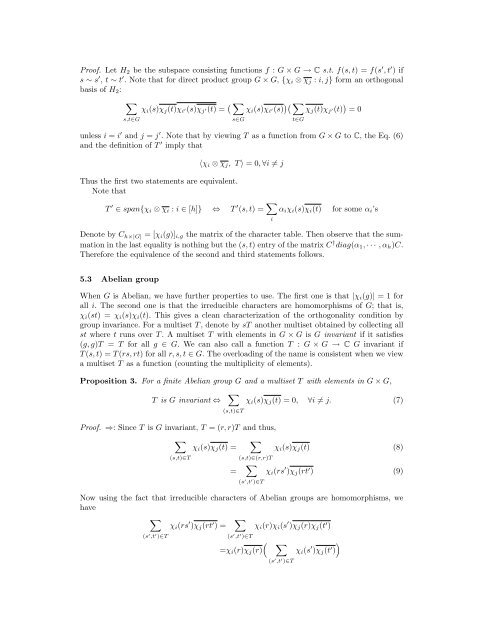
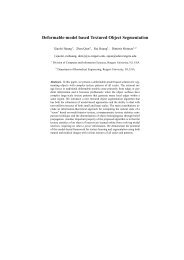
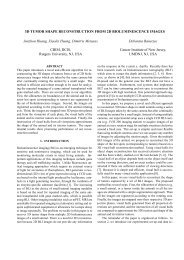
![Twitter[PDF]](https://img.yumpu.com/25710531/1/190x143/twitterpdf.jpg?quality=85)
